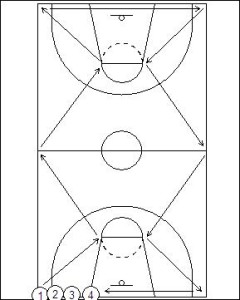Defensive Zigzag Drill
The Defensive Zigzag Drill is a staple for many coaches drill banks for teaching the fundamentals associated with the defensive slide. As an activity, the Defensive Zigzag Drill has its limitations in providing ongoing challenges for players as they become competent with playing defence, but initially when instructing in the basic teaching points of the activity it can be a great tool for exposing players to these vital elements of defensive practice.
At a lower intensity, the Defensive Zigzag Drill can be used also as a part of a sports specific warm-up activity. While not recommended for the first two or three activities within a warm-up, it can be used to round off the warm-up program and help players stretch much used muscles and utilise movements commonly found in the game of basketball.

Players line up one end of the court on the baseline.
Players start the drill one individual at a time from the corner of the court. Players must stay facing the same end of the floor as they zigzag their way down the court.
Players start in defensive stance and zigzag their way up and back down the court. Drop-stepping at each point to change direction.
The marks at which players change direction are at each quarter of the court. In the diagram above as the players move up the left hand side of the floor these points would be the elbow, sideline at halfway, elbow and then finally the baseline long corner.
Some common problems when utilising the Defensive Zigzag Drill are:
Players changing the direction they are facing when they change direction with the drop-step; players start facing a baseline and should continue to face this same direction as they zigzag down/up the floor. In the diagram above the players performing the Defensive Zigzag Drill start by facing the same baseline the players are line up along. Even though they change direction, they must still continue to defend the same basket.
Another issue will be players falling out of a good defensive stance as they slide. Players should maintain a consistently low stance and not have their head bobbing up and down with each defensive slide.
A good defensive stance also means maintaining good hand position. Depending on what the coaches philosophy is when guarding the ball players should utilise this from one end of the floor to the other. At the very least players should maintain an extended arm position with palms kept at shoulder height.
Variations include:
- Slide, Run, Slide; in this variation, players run the middle leg of the slide. Pulling out of the sprint with enough room to slide maybe once or twice before changing direction and running again.
- Practicing protective dribble with spin move; offensive variation
- 1 on 1 up the court then roles are reversed; combination of offense and defence
The Defensive Zigzag Drill is a good basic drill for introducing players to the fundamentals associated with the defensive slide and its variations commonly used during a game of basketball. A coach should remember however that once the basic technique is put in place that for the player to truly develop into a capable defensive player, they need to practice against live offensive which is able to challenge the player both with position, pace and change of direction.








Leave a Reply